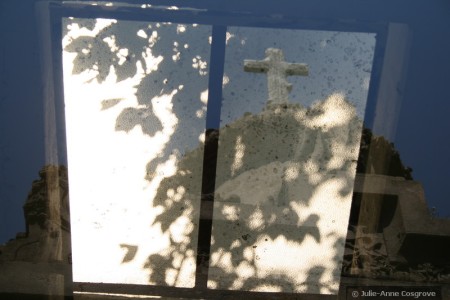Argentina, Buenos Aires, Cemeteries, Flores Cemetery
An unexpected gift
I had written it in my diary weeks ago: ‘Día de los Muertos, Flores’ for All Souls’ Day on 2 November. I woke early, excited, and the sun was shining, taking me back to childhood memories of getting ready to go to Camber Sands and cook breakfast on the beach. I know, a day trip to the cemetery isn’t everyone’s idea of fun, but I’d heard a lot about the Bolivian festivities at Flores and was fascinated.
We arrived at around 11am and all seemed normal, apart from a scattering of gendarmes and police at the entrance. After passing through the main concrete building that houses the niches (which unfortunately always looks a bit multistorey car park to me), we were out in the open, with burial grounds stretching before us and in the distance the old part, which is like a miniature Recoleta Cemetery. I was surprised there weren’t more people, so we headed to a group of three caretakers to see what they could tell us.
It seems the celebrations were wilder in the past, with lots of music and dancing and drink poured over the graves. They pointed us to the newer section of the cemetery, where they anticipated things would get going in the early afternoon. An air of expectancy was already growing and priests were buzzing around, joining families to lead their graveside prayers.
By mid-afternoon, the hordes had indeed arrived, many holding umbrellas to shield against the 28 degree sun. There were teenage boys in back-to-front baseball caps clutching bouquets, Diego Rivera señoras with plaits, and old ladies dressed from head to swollen ankles in black. Paperchains in mourning black and purple were woven through trees, and buckets and trolleys of colourful flowers trundled past, mostly gladioli, carnations and chrysanthemums, leaving scent in their wake.
I approached a woman who had a cloth laid out on the pavement, covered with bread crafted into crosses and ladders, suns and moons, dolls and even elephants. She told me she had come to Buenos Aires from Oruro in Bolivia, famous for its annual carnival, 28 years ago and hadn’t returned since. She had made the bread herself and explained that they set up the offerings at home before bringing them to the cemetery. With her permission, I took a few photos, then stood aside while three people stopped to chant prayers; in exchange they received bread to take away. Later we saw a few graves decorated with bread shapes.
We followed the call of pan pipes and a primitive drum beat to one gathering, then on to another which was brass band in style. I was touched by the sense of community, the enthusiastic bestowing of music and flowers upon the spirits of those who have gone before us. Suddenly, the daughter of the Bolivian woman I’d chatted to came rushing up to give me a carrier bag of bread, and inside was one of the elephants. What a beautiful and unexpected gift.
It would be a shame to break the chain of reflections on my blog by posting a documentary shot now, so here’s a photo I took in the old part of Flores Cemetery that afternoon. It captures something of the spirit of All Souls’ Day – a time when the veil between worlds is thin. Thank you, Bolivians, for letting me share your remembrance of those who have crossed to the other side.


I enjoyed reading
Thank you, wonderfully written.
Glad you enjoyed the post – and thank you for taking the time to leave a comment.